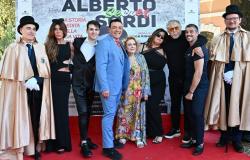AGI – It is not a gastronomic essay on the cuisine of Antiquity, rather, an itinerary in mythology linked to taste and cooking. Rizzoli (in bookshops from 11 June) will tackle the issue in “Atlante greedy of the myth. The food of the ancients. Stories, ingredients and new recipes” is Marilù Oliva, writer, essayist and literature teacher who, before arriving in the mythological field, wrote thriller and noir novels. Among his bestsellers are The Odyssey told by Penelope, Circe, Calypso and the others (2020), Snow White in the Twentieth Century (2021) and The Aeneid of Dido (2022), his latest book is The Iliad sung by dee (Solferino, 2024).
How did the idea for this ‘Greedy Atlas of Myth’ come about?
From two passions: that for mythology and that for cooking. I have been dealing with myth since 2020, when “The Odyssey told by Penelope, Circe, Calypso and the others” was released. In reality, I have always studied Greek and Roman mythology and teach the Homeric poems at school. I am also passionate about cooking, I have enjoyed cooking since I was a girl and over time, having often found myself in the position of cooking for others, I have learned to combine the playful and creative side of this activity with the more practical one (dose , times etc.). I explored the rigor of the recipes, but I discovered the pleasure of transgression, I browsed through the manuals of the past and I cultivated this interest by sharing the results with the people I love.
What kind of research did you do to write it? And how long did it take you?
I studied both on current historical-gastronomic essays and on the few available sources of the time or in the very rare recipe books, such as that of Apicius: every reference is in the final bibliography. It is always difficult for me to precisely calculate the time needed to produce a book, because it is divided into four moments: the conception (and I cannot quantify the time I dedicate to it, because the imagination subtracts it and hiccups in daily life) , the study of sources, the actual writing and revision. I can tell you that it took me about six months to write the book, but then the remaining three parts are missing!
What comes out? And how much were the ancients conditioned by food compared to modern man?
This book is an excursus through the eating habits of the ancients and their beliefs,
especially in relation to the myth. Accompanied by a rich and elegant iconographic apparatus that completes the written parts. The ancients had a cult of gastronomy that was very different from ours: if we look for increasingly refined ways of cooking and plating like stylists, responding to an elegant aesthetic taste, in Republican Rome, for example, frugality was pursued. This at least in the lower social classes, because in the upper ones we have examples of lavish dinners, bordering on hyperbole (the famous Trimalchio’s Supper, for example). For the majority of the population of the time, i.e. for the people, eating was not, as for us, a stimulation of the senses, but a mere question of survival. Let us remember that in the past the humblest classes lived on a sober, often repetitive and not even guaranteed diet, due to frequent famines and epidemics.
The least known myth related to food?
Perhaps not everyone knows that the vigorous Heracles was fond of legumes. Or that some foods had very powerful chthonic connotations, that is, they were viaticum for the world of the dead. Herodotus then tells us about peoples who fed on locusts, furthermore strawberries were connected to the cult of the beautiful (but unfortunate) Adonis. And many other curiosities that you will discover by reading…
What remains of the ancient conception of food and myth today? (if anything remains?)
I believe there is a connection between our generally healthy, varied, colorful eating habits and our geography, but also our history. We come from there, from that culture, and some dishes demonstrate this very well. Already then in Italy there were rudimentary lasagnas, for example, or legumes were cooked in ways very similar to how they are still served today in some southern Italy. In Torre Annunziata, in the Villa di Poppea, the fresco of a wonderful Sicilian cassata was found which seems to have just been packaged by the hands of a skilled contemporary pastry chef, for example.
How did you structure the book and who do you recommend reading it to?
The book is divided into food groups, starting with cereals. At the end of each chapter, Rizzoli allowed me to have fun in a tasting menu, where – respecting the habits of the ancients – I propose dishes partly invented by me. I had a lot of fun trying them! It all ends with a chapter in which I talk about flowers, mushrooms and other curiosities.
Which is the easiest to replicate? And which is the furthest from our taste?
The recipes are not difficult to make, perhaps some desserts are a little more challenging, but it depends on the chapters. You will find experiments, contaminations, new associations (for example, lentil crêpes). These are imaginative, effective proposals (pink beetroot gnocchi, for example), but accessible to everyone, since they are based on ingredients that can be found without problems, preferably fresh and with the least possible environmental impact. Among other things, I propose menus for all tastes: little meat, lots of vegetables, cereals, healthy foods that satisfy and surprise not only the palate, but also the sense of smell and sight. To regain possession of that sacred relationship – very different from the bulimic, sometimes neurotic, too fast and consumerist one of our days – that the ancients attributed to those precious moments dedicated to nourishment.
For Latest Updates Follow us on Google News





